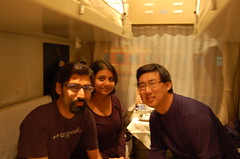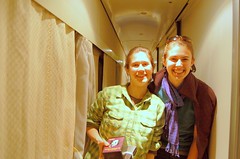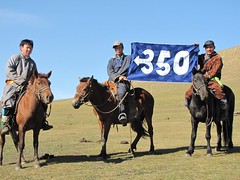 Charlie, my best friend and co-founder at BookFinder.com, met up with us in China. It was a trip he'd always wanted to make, and we were delighted that he planned his visit so that we could explore China together. We met up with Charlie in Shanghai, made our way to Xi'an, and then to Beijing. After Beijing, Charlie would fly home to the Bay Area, and we'd catch the Trans-Siberian railway, traveling through Mongolia without stopping, and on to Russia.
Charlie, my best friend and co-founder at BookFinder.com, met up with us in China. It was a trip he'd always wanted to make, and we were delighted that he planned his visit so that we could explore China together. We met up with Charlie in Shanghai, made our way to Xi'an, and then to Beijing. After Beijing, Charlie would fly home to the Bay Area, and we'd catch the Trans-Siberian railway, traveling through Mongolia without stopping, and on to Russia.
The three of us were settling into our berth on the train from Xi'an to Beijing, when we heard American voices outside, playing Scattergories. We poked our heads out, and met Alana and Kathryn, two twentysomething cousins from North Carolina traveling in China. Kathryn was a marine biologist, and Alana mentioned that she'd just spent a year in Mongolia. Our years perked up. Doing what, we asked. Studying climate change. Serendipitous paydirt! We asked if she could share some of what she'd learned.
 Alana M. Wilson was a UNC grad who spent a year in Mongolia studying climate change and renewable energy. She spent summer 2009 on Mongolian glaciers, with a team of glaciologists. Mongolia is an incredibly land-locked country, located between the vast expanse of China on one side and Russia on the other. Like glaciers the world over, these too were melting and receding. It wasn't until relatively recently that scientists had the tools to tease out the stories of the ice.
Alana M. Wilson was a UNC grad who spent a year in Mongolia studying climate change and renewable energy. She spent summer 2009 on Mongolian glaciers, with a team of glaciologists. Mongolia is an incredibly land-locked country, located between the vast expanse of China on one side and Russia on the other. Like glaciers the world over, these too were melting and receding. It wasn't until relatively recently that scientists had the tools to tease out the stories of the ice.
This had been Mongolia's coldest winter. Alana described a nation in shock, with 1.8 million livestock dead from the harsh cold, and up to 5 million more at risk. That was then -- as I write this, the number has jumped to 4.5 million livestock dead in the cold. Such ferocious winters would come once in a generation, but were now coming about once a decade, with impacts multiplied due to human and livestock population growth. Global climate change and local environmental management problems were coming together.
 "Mongolia's national identity is linked to pastoral nomadic herding," she explained, "even though only a third of the population lives that way. Overgrazing and deforestation are making that way of life impossible." She told us the story of overgrazing, which sounded like a textbook tragedy of the commons. Up until about 1991, the state had managed to preserve limits on livestock. But after the end of Communist rule, everything fell apart, with livestock numbers skyrocketing past the land's low carrying capacity. Forces like electrification were already drawing herders to towns and cities. Winters like this would make things even worse, as stricken herders moved to urban areas; would they want to go back afterwards?
"Mongolia's national identity is linked to pastoral nomadic herding," she explained, "even though only a third of the population lives that way. Overgrazing and deforestation are making that way of life impossible." She told us the story of overgrazing, which sounded like a textbook tragedy of the commons. Up until about 1991, the state had managed to preserve limits on livestock. But after the end of Communist rule, everything fell apart, with livestock numbers skyrocketing past the land's low carrying capacity. Forces like electrification were already drawing herders to towns and cities. Winters like this would make things even worse, as stricken herders moved to urban areas; would they want to go back afterwards?
We asked Alana about climate action, and she told us about the inspiring young climate activists she'd met. Given the impacts of climate change on Mongolia, they were linking combating climate change with the survival of their national culture. Three Mongolian climate activists had managed to make it to COP15, where they met and lobbied their President, and networked with youth climate activists from around the world. They came back inspired by movements in other developing countries. As activists living in a "culture where there's no such concept," participants in the movement are necessarily multi-issue, often working on human rights or other related issues.
Alana spent the fall in a town located between the deserts and the mountains, where farmers grew delicious watermelons and canteloupe, but divert about 100% of the local river's water to do so. The WWF, UNDP, and SDC were working with farmers to increase efficiency, so they could leave about 50% of the water in the river; she'd worked on a project to redo local irrigation channels. We asked Alana about government and the NGO sector. "Mongolia's a darling for development aid," she told us, with NGOs often working closely with the government. Mongolia had surprisingly strong environmental laws, and there was a lot of optimism around preservation work. The goal was to try to safeguard a third of the land, before industrial and mining concerns had the opportunity to engage in destructive practices in the mineral-rich country.
It was past midnight by the time we were done sharing stories, and we'd finally pulled out the beds in our sleeper cars. The train continued on through the night, and we were there by morning, giving us a full night's sleep. We waved goodbye to Alana and Kathryn as we headed out to our hutong hostel. Beijing awaited.
Curious about Mongolian environmental issues?
- Nomad Green citizen media project
- "Strike of the Dzud: How Conservation Can Help Mongolia's Herders"
- "Mongolia: Climate Change Affecting Nomadic Way of Life"
Our China slideshows:
Leave a comment